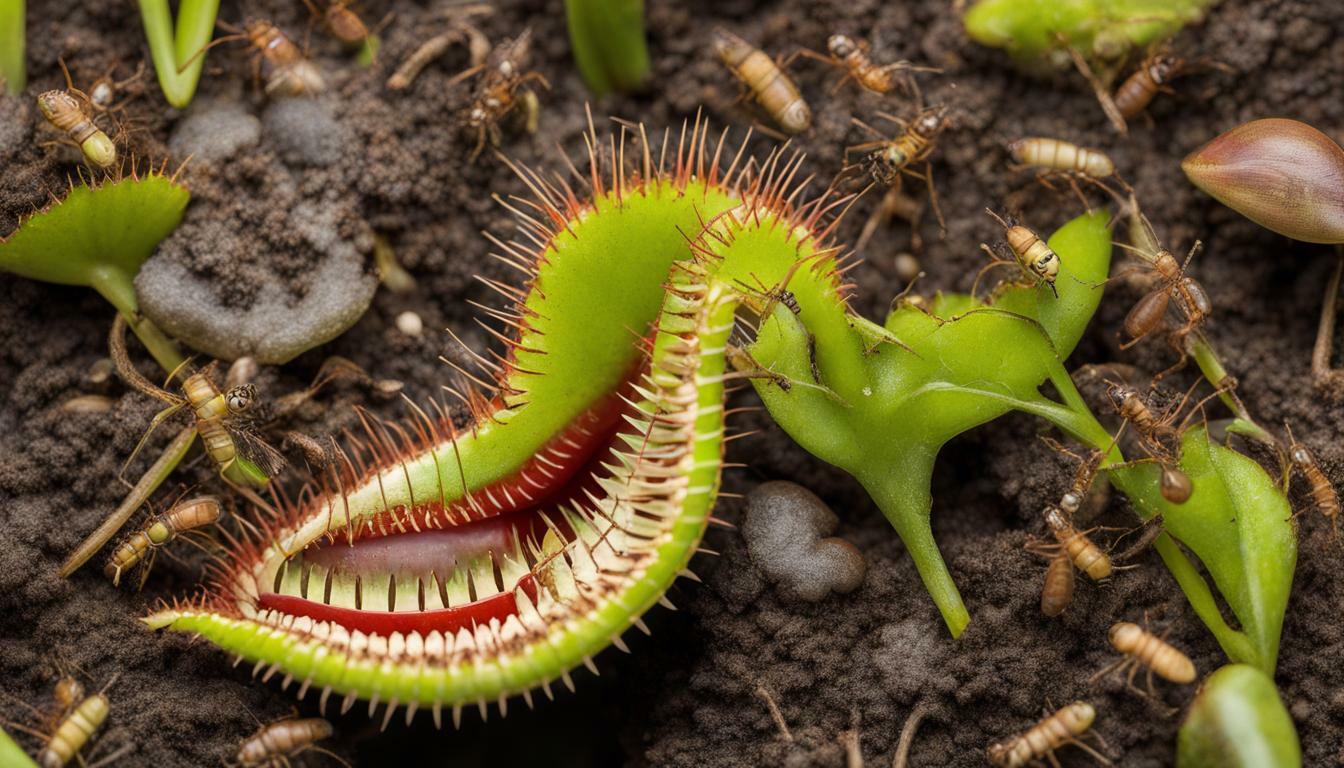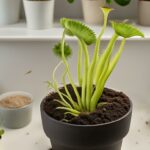Have you ever wondered how Venus flytraps survive? As carnivorous plants, Venus flytraps have unique feeding habits that set them apart from other plants. These insectivorous plants rely on insects as their primary source of nutrients, but is it necessary for their survival?
In this article, we will explore the dietary needs of Venus flytraps and how to maintain a healthy diet for these fascinating plants. Understanding their feeding habits is crucial for their successful care and maintenance.
Key Takeaways:
- Venus flytraps are carnivorous plants that require insects for essential nutrients.
- The feeding strategies of Venus flytraps include trap mechanisms and digestive enzymes.
- Maintaining a healthy diet for Venus flytraps involves providing suitable prey options and mimicking their natural environment.
Understanding Carnivorous Plants
If you’re interested in caring for Venus flytraps or other carnivorous plants, it’s essential to understand their unique feeding habits. These insectivorous plants have adapted to capture and digest insects as a way of supplementing their nutrient-poor environments.
There are many different types of carnivorous plants, but Venus flytraps are among the most well-known. They are native to the wetlands of the southeastern United States and require high levels of humidity and plenty of sunlight to thrive.
To keep your Venus flytrap healthy, you must ensure that it has access to an adequate supply of insects. Without a steady diet of bugs, these plants cannot survive. It’s also essential to mimic their natural habitat in terms of temperature, light exposure, and soil type.
Types of Carnivorous Plants
In addition to Venus flytraps, there are many other types of carnivorous plants you may encounter, such as pitcher plants, sundews, and bladderworts. Each of these plants has developed unique adaptations to capture and digest prey.
For example, pitcher plants have a deep, slippery pit filled with digestive enzymes that trap insects. Sundews have sticky, glandular hairs on their leaves that entangle and digest prey. Bladderworts have small, bladder-like structures that suck prey into a watery digestive chamber.
Depending on the species of carnivorous plant you are caring for, you will need to provide different types of prey to keep them healthy. Some plants prefer insects that fly, while others prefer ground-dwelling insects. It’s crucial to do your research and provide the correct prey for your plant’s specific needs.
Maintaining a Venus Flytrap’s Diet
Feeding carnivorous plants can be a tricky business, but with the right approach, it’s entirely possible to provide your Venus flytrap with a healthy diet. The best way to do this is to offer your plant live insects that are appropriately sized for its traps.
If you’re unable to provide live insects, you can try feeding your plant freeze-dried or pre-killed insects. However, this is not an ideal solution, as it can increase the risk of nutrient deficiencies and other health problems.
It’s also vital to avoid overfeeding your Venus flytrap. These plants can only digest a limited amount of prey at a time, and feeding them too much can lead to rotting or mold growth within the traps. A good rule of thumb is to feed your plant one small insect at a time every two weeks.
In summary, understanding the dietary needs of carnivorous plants like Venus flytraps is essential to their proper care and maintenance. By providing the correct type and amount of prey, mimicking their natural habitat, and avoiding common pitfalls, you can enjoy the unique beauty and fascinating feeding mechanisms of these remarkable plants.
The Diet of Venus Flytraps
If you’re considering growing a Venus flytrap, it’s crucial to understand their dietary needs to ensure their proper care and maintenance. As insectivorous plants, Venus flytraps rely on their unique feeding mechanism to extract essential nutrients from insects.
Their natural diet includes small insects such as flies and ants, and occasionally arachnids. However, it is important to avoid feeding them larger insects, as it may damage their traps. Venus flytraps can also be fed freeze-dried or live insects, such as crickets and fruit flies.
When feeding your Venus flytrap, be sure to provide just enough insects to satisfy their nutritional needs, without overfeeding. Overfeeding can damage the traps and lead to poor health. Generally, a Venus flytrap needs to be fed once every two to three weeks during the growing season, and once a month during the dormant season.
It is important to note that Venus flytraps are sensitive to tap water, which can contain minerals harmful to the plants. Use filtered, distilled, or rainwater to feed your Venus flytrap, and avoid fertilizing or using any soil richer than peat moss and sand. A suitable potting medium to use is sphagnum moss.
By mimicking their natural habitat, you can maintain the health of your Venus flytrap and enjoy the beauty of this unique and fascinating plant for years to come.
Feeding Strategies of Venus Flytraps
Venus flytraps have a unique feeding mechanism that sets them apart from other plants. Their leaves have evolved into traps that snap shut when triggered by an unsuspecting insect, allowing the plant to capture and digest it for essential nutrients.
There are two types of traps on a Venus flytrap: the larger leaves that form the jaws of the trap and the shorter, hair-like structures called trigger hairs. When an insect touches one of the trigger hairs, it signals the jaws to close and trap the prey inside.
Once the trap is closed, digestive enzymes are secreted from glands inside the leaves to break down the insect’s exoskeleton and extract the nutrients. This process can take several days to a week, after which the trap reopens and the remaining exoskeleton is discarded.
Venus flytraps rely solely on insects for their diet, and it’s important to provide them with a diverse range of prey in order to ensure they receive the necessary nutrients. Insects such as fruit flies, houseflies, and crickets are suitable prey options, but it’s important to avoid feeding them spiders or bugs that have been exposed to pesticides.
Feeding Venus flytraps too much or too often can lead to overstimulation, causing the traps to become less sensitive and less effective at capturing prey. It’s recommended to feed them one or two insects per trap every week or two, depending on the size of the prey and the rate of digestion.
Feeding Strategies for Venus Flytraps:
| Do’s | Don’ts |
|---|---|
| Feed your Venus flytrap a diverse range of insects, such as fruit flies, houseflies, and crickets | Feed your Venus flytrap spiders or bugs that have been exposed to pesticides |
| Feed one or two insects per trap every week or two | Feed too much or too often, which can lead to overstimulation and less effective traps |
| Allow the trap to reopen naturally and discard any leftover exoskeletons | Force open the trap or remove any leftover exoskeletons, which can damage the plant |
If your Venus flytrap isn’t capturing prey or appears weak, it may be experiencing nutrient deficiencies. In this case, it’s important to reevaluate its feeding strategy and consider supplementing its diet with a diluted fertilizer solution or providing it with more suitable prey options.
The feeding strategies of Venus flytraps are fascinating and essential to their survival. By providing them with a healthy and diverse diet, you can ensure that they thrive and continue to captivate and intrigue plant enthusiasts for generations to come.
Maintaining a Healthy Diet for Venus Flytraps
If you’ve decided to add a Venus flytrap to your collection of indoor plants, it’s essential to understand their dietary needs for optimal care. Feeding your flytrap the right insects is crucial to their survival and overall health. Here are some tips on how to maintain a healthy diet for your Venus flytrap:
Prey Options
Venus flytraps primarily eat insects, such as flies, gnats, and mosquitoes. Avoid feeding your Venus flytrap spiders, ants, or beetles as they may damage the traps or become stuck in the digestive enzymes. It’s important to provide live prey as the movement of insects triggers the trap mechanism, allowing for the plant to digest its meal.
Feeding Frequency
Feeding your Venus flytrap too frequently can exhaust its energy and lead to a weakened immune system. However, underfeeding can cause the plant to close its traps more slowly, which can prevent successful digestion. Feed your Venus flytrap every two to three weeks, or when at least two traps are open and ready for prey.
Potential Pitfalls
One of the most common mistakes when feeding Venus flytraps is overfeeding. Feeding your plant too much can cause the traps to stop closing, leading to a buildup of un-digested insects that can rot and cause damage to the trap. Another pitfall to avoid is using tap water, which contains minerals that can be harmful to Venus flytraps. It’s best to use distilled or rainwater for watering and feeding your plant.
Mimicking the Natural Environment
Venus flytraps require high humidity and bright, indirect sunlight to thrive. In their natural habitat, they grow in acidic soil, so it’s essential to mimic their environment by planting them in a mixture of peat moss, sand, and perlite. Avoid using fertilizers, as they provide nutrients that Venus flytraps don’t need and can damage the roots.
In conclusion, maintaining a healthy diet for your Venus flytrap is essential for their survival and overall well-being. By providing the right prey, feeding at the appropriate frequency, avoiding common pitfalls, and mimicking their natural environment, you can ensure a long and healthy life for your unique insectivorous plant.
Common Mistakes and Troubleshooting
Feeding Venus flytraps can be tricky, and there are several common mistakes to avoid. One of the most significant mistakes is overfeeding the plant. Venus flytraps don’t need to eat insects frequently, and overfeeding can cause harm to the plant, such as a reduction in trap size and plant vigor.
On the other hand, underfeeding is another common issue that can prevent the plant from growing properly. Venus flytraps require a consistent supply of insects to thrive, so be sure to provide enough prey for the plant to consume.
In addition, Venus flytraps are also prone to nutrient deficiencies, particularly in potassium and phosphorus. If you notice that your plant is turning yellow or has a stunted growth rate, this may be a sign of a nutrient deficiency. To address this, consider using a fertilizer specially formulated for carnivorous plants, and be sure to follow the manufacturer’s instructions closely.
One of the most important aspects of maintaining a healthy Venus flytrap diet is to provide the correct type of prey. Venus flytraps typically thrive on live insects such as crickets and flies, but they may also consume other small invertebrates such as spiders and ants. Avoid feeding your Venus flytrap with dead insects as they may not provide the necessary nutrients required by the plant.
Finally, keep in mind that a Venus flytrap’s nutritional needs will vary depending on the plant’s age, size, and growth stage. If you’re unsure of how much or how often to feed your plant, consult a professional or a reputable source for expert advice.
Maintaining a Healthy Diet for Venus Flytraps
Now that you understand the importance of feeding bugs to your Venus flytrap, it’s essential to know how to maintain a healthy diet for your carnivorous plant. Here are some practical tips to keep in mind:
Choose Suitable Prey Options
When it comes to feeding your Venus flytrap, not all bugs are created equal. They require small, soft-bodied insects like flies, spiders, and gnats, as opposed to larger, hard-bodied prey like beetles and ants. Avoid feeding your plant non-insect prey like raw meat or pet food, which will not provide the nutrients your plant needs.
Carefully Monitor Feeding Frequency
While Venus flytraps are carnivorous, they don’t need to be fed every day. Overfeeding can actually harm your plant, leading to a build-up of undigested prey in the traps and potential mold growth. Feed your plant once a week at most, or even less frequently if it’s not growing actively or producing new traps.
Mimic Their Natural Environment
To provide the best possible diet for your Venus flytrap, try to replicate its natural habitat as closely as possible. This means providing them with plenty of sunlight, moist soil, and a suitable humidity level. You can also use rainwater or distilled water to ensure that your plant is getting the purest possible water supply.
Avoid Common Pitfalls
Feeding Venus flytraps can be tricky, and there are some common mistakes to avoid. Don’t be tempted to touch the traps or feed them manually, as this can damage the plant and interfere with its feeding process. Additionally, avoid fertilizing your plant or providing it with nutrient-rich soil, as Venus flytraps prefer nutrient-poor soil and will get all the nutrients they need from their insect prey.
Conclusion
Feeding your Venus flytrap can be a rewarding experience, but it’s important to provide them with a healthy diet for optimal growth and nutrition. By choosing suitable prey options, monitoring feeding frequency, mimicking their natural environment, and avoiding common pitfalls, you can ensure that your plant stays healthy and thriving.
Can Venus Flytraps Survive Without Bugs in Low Light Conditions?
The survival of venus flytraps in low light conditions is heavily dependent on the availability of bugs. These carnivorous plants derive essential nutrients from their prey, compensating for the nutrient-poor soil. In the absence of bugs, Venus flytraps struggle to obtain sufficient energy and cannot grow adequately. It is crucial for them to be in well-lit areas to attract and capture their necessary nourishment.
FAQ
Q: Do Venus flytraps need bugs to survive?
A: Yes, Venus flytraps are carnivorous plants and rely on insects as their primary source of nutrition.
Q: What are carnivorous plants?
A: Carnivorous plants are plants that have adapted to capture and digest insects and other small prey to supplement their nutritional needs.
Q: How do Venus flytraps capture and digest insects?
A: Venus flytraps have specialized leaves with hinged traps that snap shut when triggered by the movement of an insect. They then produce digestive enzymes to break down the prey and absorb the nutrients.
Q: What should I feed my Venus flytrap?
A: Venus flytraps should be fed live insects, such as flies, spiders, or ants, to ensure they receive the necessary nutrients for their growth and survival.
Q: How often should I feed my Venus flytrap?
A: Venus flytraps should be fed about once every two to three weeks during their active growing season. In winter, they enter a dormant period and do not require feeding.
Q: Can I feed my Venus flytrap anything other than bugs?
A: It is best to stick to live insects as the primary food source for Venus flytraps. Avoid feeding them processed or cooked food, as it may contain harmful additives or lack essential nutrients.
Q: What happens if my Venus flytrap doesn’t catch enough bugs?
A: If a Venus flytrap doesn’t catch enough bugs, it may become weak and struggle to grow or reproduce. In such cases, supplemental feeding may be necessary to ensure its health.
Q: What are some common mistakes when feeding Venus flytraps?
A: Common mistakes include overfeeding, feeding non-nutritious prey, and feeding too frequently. It is important to strike a balance and provide a varied diet to maintain proper nutrition.
Q: How do I troubleshoot feeding issues with my Venus flytrap?
A: If your Venus flytrap is not capturing prey or appears unhealthy, check the environmental conditions, such as light levels and humidity. Adjusting these factors may help resolve feeding issues.
Q: Can I grow Venus flytraps indoors?
A: Yes, Venus flytraps can be grown indoors in containers. However, it is important to mimic their natural habitat as closely as possible to ensure proper growth and nutrition.











